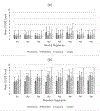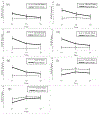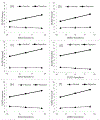Development of the A-DISS rejection task to demonstrate the unique and overlapping affective features of social anxiety and depression
- PMID: 33776170
- PMCID: PMC7992050
- DOI: 10.1007/s10608-020-10152-x
Development of the A-DISS rejection task to demonstrate the unique and overlapping affective features of social anxiety and depression
Abstract
Background: Social anxiety (SA) and depression are prevalent, often comorbid disorders, associated with poor psychosocial functioning. Experimental psychopathology approaches can clarify the transdiagnostic mechanisms underlying these disorders, but most laboratory tasks are limited. We developed and validated the Audio-Dialogue Inductions of Social Stress (A-DISS) experimental task to model real-time rejection sensitivity in a realistic and developmentally relevant context. Participants are asked to imagine overhearing peers at a party talking badly about them (Rejection) or a teacher at their school (Neutral).
Methods: Study 1 focused on identifying and refining stimuli that elicited relevant emotional responses for Rejection (e.g., increased anxiety) and Neutral (e.g., no emotional changes) conditions (N=48). Study 2 examined whether participants' SA and depression symptoms moderated the effects of A-DISS condition (N=52).
Results: The Rejection condition elicited higher negative affect/lower positive affect while the Neutral condition sustained stable affect. Findings were consistent across gender and race/ethnicity. Moderation analyses were statistically significant; participants with elevated SA or depression reported feeling more rejected, insecure, and anxious after Rejection than those with below average symptoms.
Conclusions: Findings provide preliminary validation of a novel peer rejection task for research on understanding the affective experience of real-time rejection overall, especially for those with elevated SA and depression. SA and depression symptoms each uniquely moderating the effects of Rejection exposure on similar affective states, suggests individuals with SA or depression may benefit from interventions targeting specific reactions to rejection/stress and transdiagnostic risk factors.
Keywords: Anxiety; Depression; Experimental Psychopathology; Rejection; Social Stress.
Conflict of interest statement
Conflict of interest Renee Cloutier, Sarah Bilsky, Catherine Baxley, Kristen Anderson, and Heidemarie Blumenthal declare that they have no conflicts of interest.
Figures





Similar articles
-
An experimental investigation of peer rejection and social anxiety on alcohol and cannabis use willingness: Accounting for social contexts and use cues in the laboratory.Psychol Addict Behav. 2021 Dec;35(8):887-894. doi: 10.1037/adb0000711. Epub 2021 Apr 29. Psychol Addict Behav. 2021. PMID: 33914564 Free PMC article. Clinical Trial.
-
Cognitive distortions mediate depression and affective response to social acceptance and rejection.J Affect Disord. 2016 Jan 15;190:792-799. doi: 10.1016/j.jad.2015.11.015. Epub 2015 Nov 19. J Affect Disord. 2016. PMID: 26625091 Free PMC article. Clinical Trial.
-
Deployment of personnel to military operations: impact on mental health and social functioning.Campbell Syst Rev. 2018 Jun 1;14(1):1-127. doi: 10.4073/csr.2018.6. eCollection 2018. Campbell Syst Rev. 2018. PMID: 37131363 Free PMC article.
-
Neurophysiological Responses to Interpersonal Emotional Images: Associations with Symptoms of Depression and Social Anxiety.Cogn Affect Behav Neurosci. 2021 Dec;21(6):1306-1318. doi: 10.3758/s13415-021-00925-6. Epub 2021 Jul 16. Cogn Affect Behav Neurosci. 2021. PMID: 34272679 Free PMC article.
-
[Vulnerability to depression in children and adolescents: update and perspectives].Encephale. 2002 May-Jun;28(3 Pt 1):234-40. Encephale. 2002. PMID: 12091784 Review. French.
Cited by
-
An experimental investigation of peer rejection and social anxiety on alcohol and cannabis use willingness: Accounting for social contexts and use cues in the laboratory.Psychol Addict Behav. 2021 Dec;35(8):887-894. doi: 10.1037/adb0000711. Epub 2021 Apr 29. Psychol Addict Behav. 2021. PMID: 33914564 Free PMC article. Clinical Trial.
References
-
- Akibar A, Niemann YF, Blumenthal H, & Vosvick M (2019). Dimensions of sexuality and social anxiety in emerging adulthood. Journal of Gay & Lesbian Mental Health, 23(2), 244–266.
-
- Amir N, Beard C, & Bower E (2005). Interpretation bias and social anxiety. Cognitive Therapy and Research, 29(4), 433–443. 10.1007/s10608-005-2834-5 - DOI
-
- Asher M, Asnaani A, & Aderka IM (2017). Gender differences in social anxiety disorder: A review. Clinical Psychology Review, 56, 1–12. https://doi-org.umiss.idm.oclc.org/10.1016/j.cpr.2017.05.004 - DOI - PubMed
-
- Audacity Team (2019). Audacity(R): Free Audio Editor and Recorder [Computer application]. Version 2.3.2 retrieved May 20th 2019 from https://audacityteam.org/ [1].
Grants and funding
LinkOut - more resources
Full Text Sources
